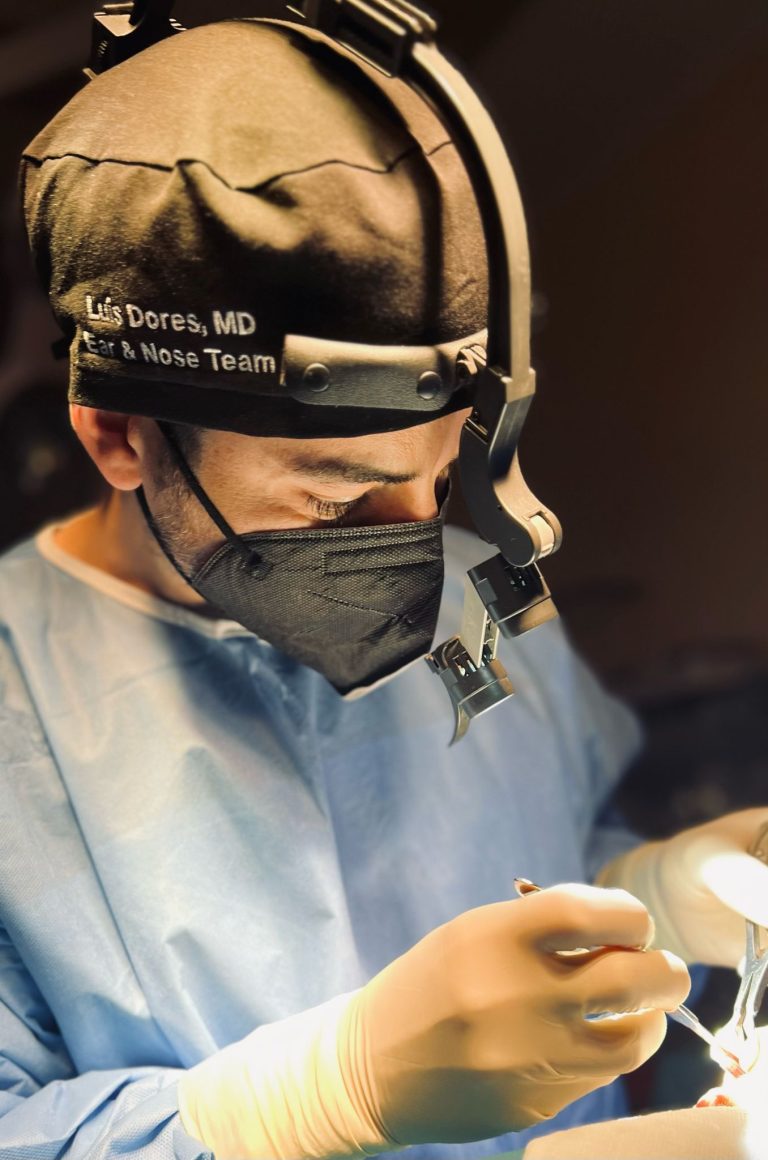After finishing his ENT residency in Lisbon, Dr. Luís Dores started his career as a specialist in the Algarve in 2015, a place where he already had professional experience and where he wanted to develop his medical scientific career. “I started working in the public sector at the hospital in Portimão and Faro, as well as the HPA clinics.”
Currently, Dr.’s primary surgical focus is Luís is Rhinology (nose and paranasal sinuses), rhinoplasty, otoplasty (prominent ear deformity) and also coordinates the “Head and Neck Multidisciplinary Team” dealing with benign and malignant head and neck pathologies. In the private sector, he is employed at the HPA clinics in Alvor and Guia. pediatric surgeries are done at Gambela Hospital in Faro,” the doctor said.
Dr. Luís Dores distinguished himself in the field of Rhinology during his academic career. “My entire training, theoretical and practical, was focused on the field of Rhinology. Not only did I learn how to treat rhinitis and sinusitis medically and surgically, but I also began to study the aesthetic aspect of the nose,” he says. Luís Dores completed his undergraduate studies at the University of Lisbon School of Medicine, located at St. Maria, between 2002 and 2008. In 2009, he completed a general internship at Portimão Hospital, where he was exposed to several medical and surgical specialties.
In order to become an ENT specialist, Dr. Luís returned to Hospital St. Maria in 2010, where he studied for an additional five years. He also had the opportunity to do a six-month internship in “Facial Plastic Surgery” in London at Lewisham University Hospital. “I completed an internship with an ENT surgeon in London during my training, which was dedicated to facial plastic surgery – basically everything related to medical and surgical treatments of the face, mainly Rhinoplasty and Otoplasty.” He stresses, saying: “I knew right away that I wanted to come back to the Algarve as a specialist after that internship I did here in Portimao; after my internship in London, I took the final specialist exam and came straight to the Algarve.” .
According to Dr. Luís Dores, “Rhinology is the medical science dedicated to the anatomy, physiology and diseases of the nose and sinuses. In the context of Rhinology, we mainly deal with rhinitis and sinusitis which cause symptoms such as nasal obstruction, nasal congestion, headaches, chronic cough and disorders of smell.’ He explained that a Rhinoplasty operation can address both functional and aesthetic issues. If a patient has a severe nose drop, this means that the air passage is not properly transported, which will cause both a cosmetic and a functional breathing problem for the patient. “There are structural elements of the nose that, when operated on to improve the functional part, also end up altering its aesthetics and vice versa.”
When asked what prompts people to see a specialist in this area, Dr. Dores said, “It often depends on the patient’s complaint.” Some patients see a specialist primarily for functional problems, while others do so for cosmetic reasons. However, he emphasized that, from time to time, patients who come to see him for functional problems also express discomfort with the appearance of their noses. “So we realize that we can treat not only the functional part, but we can complement the treatment with an element of aesthetics.” But as the doctor notes, the reverse is also possible. “Some patients seek our care just for their appearance, but during consultations and imaging tests, we find that they also have some functional issues. We then take advantage of those findings and treat both with the same procedure.”
The standard procedure involves an initial consultation during which potential functional and anatomical abnormalities are evaluated. As Dr. Luís explained, “In that first appointment a photographic record is made and an immediate simulation of the result we want in the long term is carried out with a computer simulation.” At the second consultation, when the results of the tests are already available, Dr. Dores says that “We make the surgical proposal and after six or eight weeks we can proceed with the surgery.” The surgeon explains that most rhinoplasty procedures, which are a procedure performed under general anesthesia and typically take about three to four hours, are done as outpatient procedures, meaning the patient goes home the same day.
“We have the first post-operative consultation one week after surgery, during which the external cast and nasal splint (if needed) are removed. From that point on, the patient can start living a normal life. After 15 days a final appointment is made, where the patient can start exercising. As stated by Dr. Luís Dores “The best rhinoplasty are the ones you can’t see; they are the ones where the patient feels better and more confident about himself. The main result is not the nose job itself, but rather the improvement of his facial harmony patient, which you can’t always say was achieved with rhinoplasty”.
After studying Journalism for five years in the UK and Malta, Sara Durães returned to Portugal to pursue her passion for writing and connecting with people. A “wanderer”, Sara loves the beach, long walks and sports.

Sara J. Durães
Denial of responsibility:
The views expressed on this page are those of the author and not of The Portugal News.

